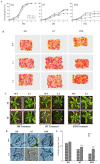The Copper Chaperone Protein Gene GmATX1 Promotes Seed Vigor and Seedling Tolerance under Heavy Metal and High Temperature and Humidity Stresses in Transgenic Arabidopsis
- PMID: 35631750
- PMCID: PMC9143580
- DOI: 10.3390/plants11101325
The Copper Chaperone Protein Gene GmATX1 Promotes Seed Vigor and Seedling Tolerance under Heavy Metal and High Temperature and Humidity Stresses in Transgenic Arabidopsis
Abstract
Abiotic stresses such as high temperature, high humidity, and heavy metals are important factors that affect seed development and quality, and restrict yield in soybean. The ATX1-type copper chaperones are an important type of proteins that are used for maintaining intracellular copper ion homeostasis. In our previous study, a copper chaperone protein GmATX1 was identified in developing seeds of soybean under high temperature and humidity (HTH) stresses. In this study, the GmATX1 gene was isolated, and multiple alignment analysis showed that its encoding protein shared high sequence identities with other plant orthologues of copper chaperone proteins containing the HMA domain, and a conserved metal ion-binding site, CXXC. A subcellular localization assay indicated that GmATX1 was localized in the cell membrane and nucleus. An expression analysis indicated that GmATX1 was involved in seed development, and in response to HTH and heavy metal stresses in soybean. GmATX1-silent soybean seedlings were found to be more severely damaged than the control under HTH stress. Moreover, the silencing of GmATX1 reduced antioxidase activity and reactive oxygen species (ROS) scavenging ability in the seedling leaves. The overexpression of GmATX1 in Arabidopsis improved seed vigor and seedling tolerance, and enhanced antioxidase activity and ROS scavenging ability under HTH and heavy metal stresses. Our results indicated that GmATX1 could promote seed vigor and seedling tolerance to HTH and heavy metal stresses in transgenic Arabidopsis, and this promotion could be achieved by enhancing the antioxidase activity and ROS scavenging ability.
Keywords: GmATX1; heavy metal; high temperature and high humidity stress; seed development; seed vigor; tolerance.
Conflict of interest statement
The authors declare that they have no conflict of interest.
Figures







Similar articles
-
Phenylalanine Ammonia Lyase GmPAL1.1 Promotes Seed Vigor under High-Temperature and -Humidity Stress and Enhances Seed Germination under Salt and Drought Stress in Transgenic Arabidopsis.Plants (Basel). 2022 Nov 25;11(23):3239. doi: 10.3390/plants11233239. Plants (Basel). 2022. PMID: 36501278 Free PMC article.
-
Gm1-MMP is involved in growth and development of leaf and seed, and enhances tolerance to high temperature and humidity stress in transgenic Arabidopsis.Plant Sci. 2017 Jun;259:48-61. doi: 10.1016/j.plantsci.2017.03.005. Epub 2017 Mar 18. Plant Sci. 2017. PMID: 28483053
-
Quantitative proteomic, physiological and biochemical analysis of cotyledon, embryo, leaf and pod reveals the effects of high temperature and humidity stress on seed vigor formation in soybean.BMC Plant Biol. 2020 Mar 26;20(1):127. doi: 10.1186/s12870-020-02335-1. BMC Plant Biol. 2020. PMID: 32216758 Free PMC article.
-
Heavy-metal-induced reactive oxygen species: phytotoxicity and physicochemical changes in plants.Rev Environ Contam Toxicol. 2014;232:1-44. doi: 10.1007/978-3-319-06746-9_1. Rev Environ Contam Toxicol. 2014. PMID: 24984833 Review.
-
Subcellular Proteomics to Elucidate Soybean Response to Abiotic Stress.Plants (Basel). 2023 Aug 4;12(15):2865. doi: 10.3390/plants12152865. Plants (Basel). 2023. PMID: 37571018 Free PMC article. Review.
Cited by
-
Phenylalanine Ammonia Lyase GmPAL1.1 Promotes Seed Vigor under High-Temperature and -Humidity Stress and Enhances Seed Germination under Salt and Drought Stress in Transgenic Arabidopsis.Plants (Basel). 2022 Nov 25;11(23):3239. doi: 10.3390/plants11233239. Plants (Basel). 2022. PMID: 36501278 Free PMC article.
References
-
- Zarkadas C.G., Gagnon C., Gleddie S., Khanizadeh S., Cober E.R., Guillemette R.J.D. Assessment of the protein quality of fourteen soybean [Glycine max (L.) Merr.] cultivars using aminoacid analysis and two-dimensional electrophoresis. Food Res. Int. 2007;40:129–146. doi: 10.1016/j.foodres.2006.08.006. - DOI
-
- Shu Y.J., Tao Y., Wang S., Huang L.Y., Yu X.W., Wang Z.K., Chen M., Gu W.H., Ma H. GmSBH1, a homeobox transcription factor gene, related to growth and development and involves in response to high temperature and humidity stress in soybean. Plant Cell Rep. 2015;34:1927–1937. doi: 10.1007/s00299-015-1840-7. - DOI - PubMed
-
- Tang G.X., Song W.J., Xu L., Jin Z.L., Subrahmaniyan K., Zhou W.J. Sowing seasons and drying methods during post-harvest influence the seed vigour of soybean (Glycine max (L.) Merr.) Acta Physiol. Plant. 2006;28:273–280. doi: 10.1007/BF02706541. - DOI
-
- Ren C., Bilyeu K.D., Beuselinck P.R. Composition, vigor, and proteome of mature soybean seeds developed under high temperature. Crop Sci. 2009;49:1010–1022. doi: 10.2135/cropsci2008.05.0247. - DOI
Grants and funding
LinkOut - more resources
Full Text Sources

